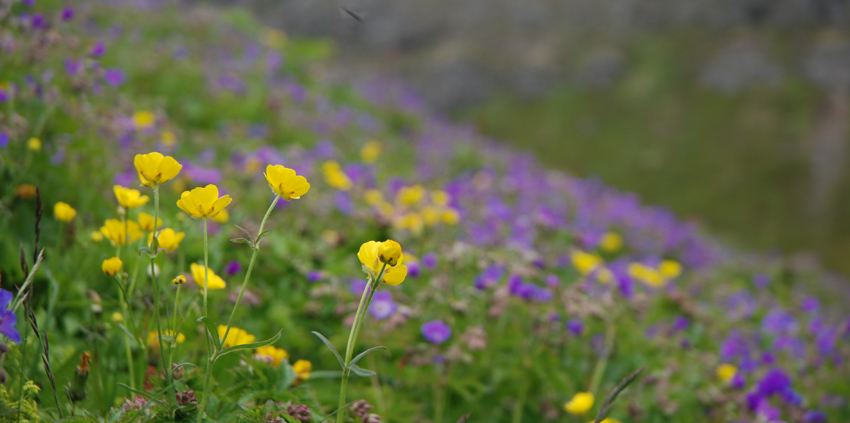 Foto: Länsstyrelsen Jämtland
Foto: Länsstyrelsen JämtlandPlant life
From a distance, Sonfjället’s sea of rocks and boulders looks quite grey and lifeless. But when you get closer, you discover that the surfaces are covered with lichen.
The most common is the yellowish-green map lichen. Also present here are star-tipped reindeer lichen, Iceland moss and grey and yellowish-white reindeer lichen. Growing among the lichens are crowberry, blue heath, bilberry and dwarf birch.
Other species that can handle such an extreme climate are crinkled snow lichen, trailing azalea, mountain bearberry and diapensia.
Plants and butterflies
In sheltered brook ravines – for example, in Sododalen – tall plants such as twisted sedge and wood crane's-bill grow along with alpine lady’s-mantle, alpine lady's-fern, red campion, alpine cat's-tail and many other plants.
In Sododalen if you are lucky, you may get to see the little alpine blue, Härjedalen’s landscape butterfly. In Sweden it exists only in the Jämtland and Härjedal mountains.
Different kinds of forest
There are several different kinds of forest in the national park, everything from lush mountain birch forests to dry, sparse pine forests.
The most common forest type on dry land in Sonfjället National Park is the sparse, tall heath, with its abundance of lichens. Star-tipped reindeer lichen, Iceland moss and grey and yellowish-white reindeer lichen thrive here along with heather, lingonberries and crowberries. Old, gnarled and contorted pine trees, which grow slowly in this scanty and harsh environment, create a sense of untouched forest around the mountain.
The forest in the national park has been affected in part by logging around the turn of the 20th century. In addition, forest fires have afflicted certain parts several times.
On the damper ground, lush spruce forests grow. Many different mosses, including stair-step moss and big red stem moss, cover the ground. Bilberry sprigs thrive here along with plants such as goldenrod, two-leaved maianthemum, wood crane's-bill, chickweed wintergreen, common and small cow-wheat and meadowsweet.
Some of the spruce trees are approaching 250 years of age. Here and there dry, dead trees stand. Tree trunks that long ago were shattered by some storm lie on the ground and decay. The sense of a primeval forest is strong, and it is reinforced by the hanging lichens that adorn the trees.
The oldest clonal tree
Old Rasmus, one of the world’s oldest living clonal trees (at least 9,500 years old), is on Sonfjället. Nothing of the original tree is still alive, but genetically it is the same individual. The lowest branches have put out roots when the tree was pressed down against the ground, and new trunks have grown up.
Marshes with cloudberries
Where the ground is wettest, the forest is broken up by marshes and marsh sections, sometimes interspersed with dry grasslands where a few gnarled marsh pines have succeeded in gaining a foothold.
The coveted cloudberry grows here along with plants that love moisture, such as dwarf birch, bog bilberry and bog-rosemary.
Share with your friends
Share this page with your friends on Facebook, X (formerly Twitter), Google+ and e-mail.





